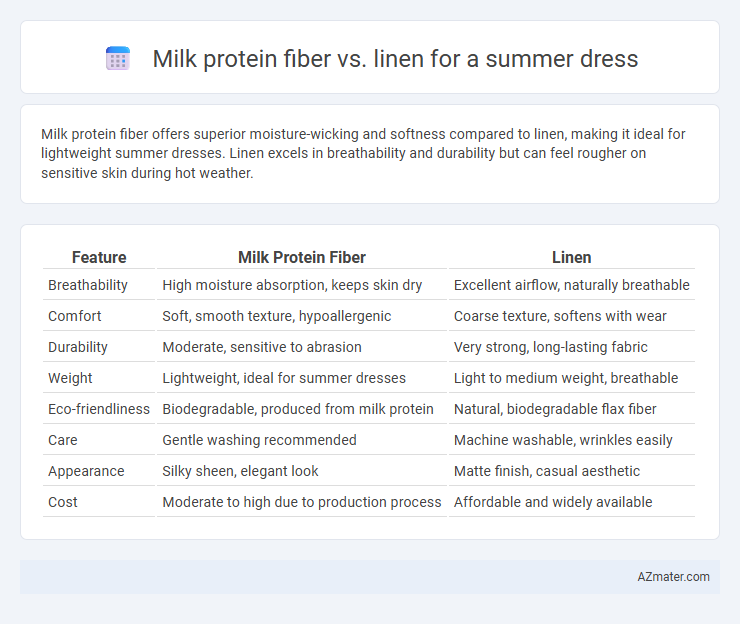Milk protein fiber offers superior moisture-wicking and softness compared to linen, making it ideal for lightweight summer dresses. Linen excels in breathability and durability but can feel rougher on sensitive skin during hot weather.
Table of Comparison
| Feature | Milk Protein Fiber | Linen |
|---|---|---|
| Breathability | High moisture absorption, keeps skin dry | Excellent airflow, naturally breathable |
| Comfort | Soft, smooth texture, hypoallergenic | Coarse texture, softens with wear |
| Durability | Moderate, sensitive to abrasion | Very strong, long-lasting fabric |
| Weight | Lightweight, ideal for summer dresses | Light to medium weight, breathable |
| Eco-friendliness | Biodegradable, produced from milk protein | Natural, biodegradable flax fiber |
| Care | Gentle washing recommended | Machine washable, wrinkles easily |
| Appearance | Silky sheen, elegant look | Matte finish, casual aesthetic |
| Cost | Moderate to high due to production process | Affordable and widely available |
Introduction to Sustainable Summer Fabrics
Milk protein fiber offers a sustainable alternative to traditional textiles, derived from casein proteins in milk, and boasts softness, breathability, and natural moisture-wicking properties ideal for summer dresses. Linen, made from flax fibers, is a classic eco-friendly fabric known for its exceptional breathability, durability, and lightweight feel, making it highly suitable for hot weather. Both fibers provide biodegradable and renewable options that reduce environmental impact while enhancing comfort during summer.
What is Milk Protein Fiber?
Milk protein fiber is a sustainable, eco-friendly textile made from casein, a protein found in milk, and is known for its softness, breathability, and moisture-wicking properties, making it an excellent choice for summer dresses. Compared to linen, milk protein fiber offers a smoother texture and better elasticity while still providing natural ventilation and comfort in hot weather. It also has antibacterial qualities and gentle skin benefits, enhancing wearability during long summer days.
Understanding Linen: A Classic Choice
Linen, derived from the flax plant, is celebrated for its exceptional breathability and moisture-wicking properties, making it ideal for summer dresses. Its natural fibers offer a lightweight yet durable fabric that enhances comfort in hot weather by allowing air to circulate and keeping the wearer cool. Linen's classic texture and eco-friendly qualities make it a timeless and sustainable option compared to synthetic alternatives like milk protein fiber.
Breathability and Comfort in Hot Weather
Milk protein fiber offers excellent breathability and moisture-wicking properties, making it highly comfortable for summer dresses by keeping the skin dry and cool. Linen, known for its natural airflow and lightweight texture, also provides superior ventilation, enhancing comfort during hot weather. Both fibers excel in breathability, but milk protein fiber adds a soft, smooth feel, whereas linen delivers a crisp, textured touch.
Moisture-Wicking Properties Compared
Milk protein fiber exhibits superior moisture-wicking properties compared to linen, actively drawing sweat away from the skin to enhance comfort in hot weather. This fiber's natural absorbency and quick-drying capabilities prevent dampness and reduce the risk of irritation during intense heat. Although linen is breathable and has some moisture-wicking ability, milk protein fiber's unique molecular structure offers more efficient moisture management for summer dresses.
Environmental Impact: Milk Protein Fiber vs Linen
Milk protein fiber, derived from casein in milk, presents a biodegradable and sustainable alternative with a low environmental footprint due to its renewable source and energy-efficient production. Linen, made from flax plants, is highly eco-friendly, requiring minimal water, pesticides, and fertilizers, and it enhances soil health through crop rotation. Both fibers offer significant environmental benefits; however, linen's cultivation process typically results in lower overall carbon emissions and greater soil sustainability compared to milk protein fiber production.
Durability and Longevity of Each Fabric
Milk protein fiber offers moderate durability with a soft texture that resists wrinkles and maintains shape, making it suitable for lightweight summer dresses that hold up over time. Linen, known for its exceptional strength and natural breathability, boasts superior longevity and becomes softer with each wash while maintaining structural integrity even in hot, humid conditions. While milk protein fiber provides comfort and gentle durability, linen outperforms in long-term wear and resistance to environmental stressors, making it a preferred choice for durable summer apparel.
Texture and Feel on the Skin
Milk protein fiber offers a silky, smooth texture that feels gentle and breathable against the skin, making it ideal for sensitive or easily irritated skin during hot summer days. Linen, known for its crisp and slightly coarse texture, provides excellent airflow and moisture-wicking properties but may feel rougher and less soft compared to milk protein fiber. Choosing between these materials depends on the preference for ultra-soft comfort versus traditional breathability and cooling effects in summer dresses.
Style Versatility for Summer Dresses
Milk protein fiber offers a silky smooth texture and excellent moisture-wicking properties, making it ideal for breathable, comfortable summer dresses with a modern, sleek style. Linen showcases a natural, textured appearance that lends a timeless, casual-chic vibe, perfect for effortless layering and versatile summer outfits. Both fibers provide unique style versatility, with milk protein fibers leaning toward refined elegance and linen embracing relaxed, breathable sophistication.
Care and Maintenance Differences
Milk protein fiber offers a smooth texture and is naturally antibacterial, requiring gentle hand washing or delicate machine cycles to maintain its softness and prevent damage. Linen is highly durable but prone to wrinkles and may shrink if washed improperly; it benefits from cold water washing and air drying to preserve its breathability and structure. While milk protein fiber demands careful handling due to its delicate nature, linen allows for more rigorous washing but needs prompt ironing to maintain a polished look.

Infographic: Milk protein fiber vs Linen for Summer dress
 azmater.com
azmater.com